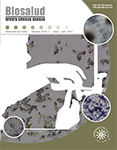Autores/as
Resumen
Introducción: La Diabetes Mellitus (DM) es una enfermedad metabólica que se caracteriza por presentar valores elevados de glicemia debido a la disminución total o parcial de la insulina en el organismo o resistencia a la misma por los tejidos periféricos. Las complicaciones de la DM son frecuentes, por lo tanto se hace necesario incentivar la búsqueda de nuevos fármacos hipoglucemiantes que complementen el protocolo actual de tratamiento. Las complicaciones de la DM son cada vez más frecuentes, por ende se requiere incentivar la búsqueda de nuevas alternativas terapéuticas que complementen el protocolo actual de tratamiento de la DM. La planta medicinal Salvia amarissima Ortega es una planta abundante en el Estado de México, usada ampliamente en la medicina tradicional para el control de la DM. Objetivo: comprobar el efecto hipoglucemiante de Salvia amarissima Ortega, para lo cual se realizó un estudio experimental, tipo exploratorio, descriptivo y analítico. Material y Métodos: se determinó la DL50 empleando el método de Lorke y se realizó una curva de tolerancia a la glucosa con ratones macho de la cepa C57BL/6J con un peso de 25 g + 5 g, con dextrosa al 35% a dosis de una centésima parte de su peso, se dividieron en nueve grupos con una n:6 cada grupo. El extracto etanólico se administró vía intragástrica, se midió la glucosa a los 0, 30 y 60 y 90 minutos. Resultados: Las hojas de Salvia amarissima Ortega presenta dosis letal 50 a los 5,3 g/kg de peso y presenta actividad hipoglucemiante a dosis de 125, 250, 500 y 1000 mg/kg de peso.
Palabras clave
Citas
2. GPC. 2014. Guía de práctica clínica: Tratamiento de la Diabetes Mellitus tipo 2 en el primer nivel de Atención, México: Instituto Mexicano del Seguro Social.
3. Olaiz F, Rivera D, Shama L, Rojas R, Villalpando H, Ávila M. 2016. Encuesta Nacional de Salud y Nutrición. Cuernavaca, México: Instituto Nacional de Salud Pública.
4. Guzmán J, Lyra R, Aguilar S, Cavalcanti S, Escaño F, Tambasia M. 2010. Treatment of type 2 diabetes in Latin American: a consensus statement by the America associations of 17 Latin American Countries. Revista Panamericana de Salud Pública, 28(6): 63-71.
5. INEGI, 2018. Características de las defunciones registradas en México durante 2017. Comunicado de prensa 521:1-3.
6. Olivares R, Arellano P. 2008. Bases Moleculares de las Acciones de la Insulina, REB 27(1): 9-18.
7. Carramiñana B. 2014. Papel de los hipoglucemiantes orales clásicos en el tratamiento actual, Rev. Medicina de Familia SERMEGEN, 40(2): 9-15.
8. Bussmann R, Sharon D. 2015. Plantas medicinales de los Andes y la Amazonia. 1ra Ed. Biblioteca nacional del Perú, Trujillo Perú, pág. 7-20.
9. Revilla C, Andrade A, Palomino G, Wiedenfield H, Islas S. 2007. Hypoglycemic effect. Journal of Ethnopharmacology,11: 636-640.
10. Akram E, Maryam E. 2009. Antidiabetic effects of sage (Salvia officinalis L.) leaves in normal and streptozotocin-induced diabetic rats. Diabetes & Metabolic Syndrome: Clinical Research & Reviews 3: 40-44.
11. López F, Sánchez D, Arrieta B, Román G, 2010. Estudio preliminar fitoquímico y de la actividad antimicrobiana de Salvia amarissima Ortega, Investigación Universitaria Multidisciplinaria, (9) 63-76.
12. Martínez N, Cayama E, Goncalvez L, Labrador S, Espino C, Pérez L. 2009. Efecto hipoglicemiante de la planta Bauhinia purpurea l., en ratones euglicémicos. Rev. Comunidad y Salud, 7 (2):
45-51.
13. Avendaño G. 2013. Libro Saberes y prácticas en torno a la salud y bienestar, capítulo “La Diabetes Mellitus su identificación, tratamiento y control a través de la medicina tradicional en algunas comunidades del Estado de Hidalgo. La Diabetes Mellitus su identificación, tratamiento y control a través de la medicina tradicional en algunas comunidades del estado de Hidalgo pág. 373-374.
14. Domínguez X. 1979. Métodos de investigación Fitoquímica. México Ed. Limusa: pág. 84-218.
15. Ibarra J, Cantú C, Verde J, Oranday A. 2009. Caracterización Fitoquímica y Efecto Hipoglucemiante de Tecoma stans y su Relación con la Presencia del Cromo como Factor de Tolerancia a la Glucosa, Información tecnológica, 20 (5), 55-65.
16. NOM-062-ZOO-1999, Especificaciones técnicas para la producción, cuidado y uso de animales de laboratorio. México, DF: Diario Oficial de la Federación.
17. Lorke D. (1983). A New Approach to Practical Acute Toxicity Testing. Archives of Toxicology, 54: 275- 287.
18. Grover J, Yadav D, Vats V. 2002. Medicinal plants of India with antidiabetic potential. Journal of Ethnopharmacology, 81: 81-100.
19. Silva F, Spoganicz B, Pizzolatti M, Willrich M. De Sousa E. 2002. Acute effect of Bauhinia forficata on serum glucose levels in normal and alloxan-induced diabetic rats. Journal of Ethnopharmacology, 83: 33-37.
20. Vishnu C, Anjana T, Banerjii A, Gopalakrishnapillai A. 2010. Gallic acid induces GLUT4 translocation and glucose uptake activity in ET3-L1 cells. Febs Letters 584:531-536.
21. Ranganathan P, Mainzen P, Kumar R, Selvakumari J. 2011. Antihyperglycemic, antilipid peroxidative and antioxidant effect of gallic acid on streptozotocin induced diabetic winstar rats. European Journal of Pharmacology. 650(1): 465-471.

 pdf
pdf
 FLIP
FLIP



















